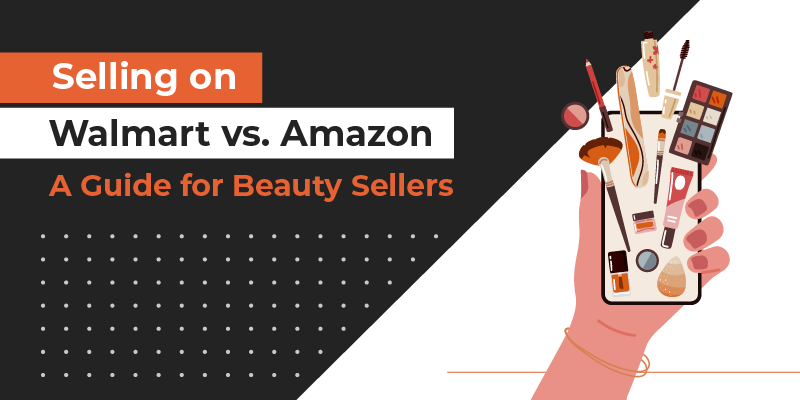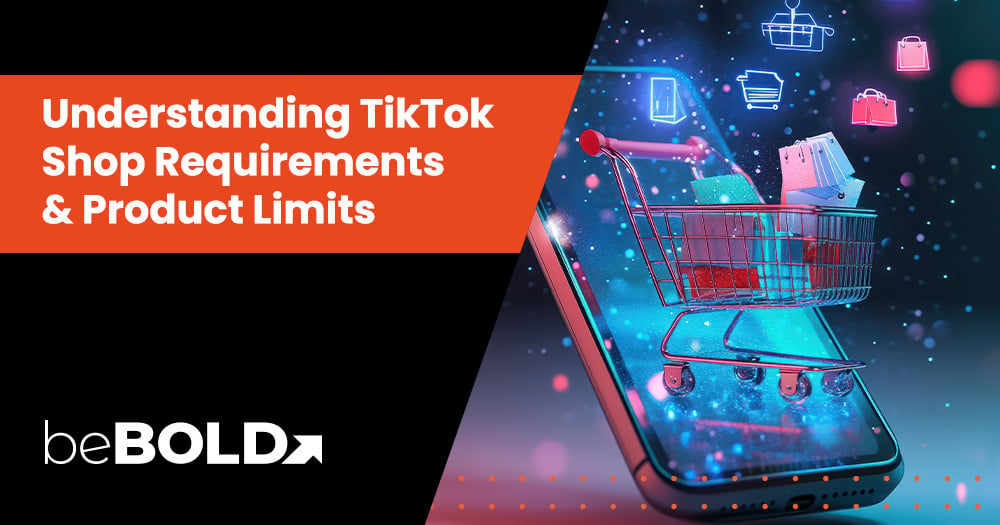The beauty product industry is booming, attracting entrepreneurs and established brands alike. As a beauty seller, you likely know of the vast potential that online marketplaces hold as retail platforms. However, choosing one to showcase your products can be overwhelming with so many options.
In eCommerce, two giants stand out: Walmart and Amazon. These industry powerhouses offer incredible opportunities for beauty sellers. However, when deciding between the two platforms, it’s essential to delve into the intricacies of the Walmart and Amazon comparison. The right marketplace can significantly impact your beauty business’s success.
This infographic delves into the nuances of selling on Walmart vs. Amazon, equipping you with the knowledge to pick the best for you. It explores the unique advantages and challenges that each platform presents, as well as provides valuable tips for success in navigating these online marketplaces.
%20(1).png?width=800&height=5870&name=BeBold%20-%20Info2%20(1)%20(1).png)
Walmart Beauty vs. Amazon Beauty
Walmart Beauty and Amazon Beauty offer a wide range of similar product categories, making them attractive platforms for beauty sellers. Both marketplaces cater to the diverse needs of beauty enthusiasts and provide opportunities to showcase and sell your products.
Categories found on both marketplaces include hair care, skincare, makeup, bath and body, fragrance, nail care, oral care, and beauty tools and accessories.
What is Premium Beauty?
Both companies have the Premium Beauty category, offering luxury and high-end products. The difference between Walmart and Amazon Premium Beauty is who gets to be on it.
Amazon’s Premium Beauty section lets third-party retailers apply if they meet specific qualifications. It allows for opportunities for a wider range of luxury beauty brands and sellers to showcase their products to Amazon’s vast customer base.
On the other hand, Walmart’s Premium Beauty primarily consists of their partnered luxury brands’ products. Walmart is more exclusive, as it can be difficult for newer sellers and unestablished brands to enter its Premium Beauty catalog.
Walmart’s Beauty Box
Walmart Beauty offers a service that Amazon doesn’t: the Beauty Box. A subscription gets customers an assortment of beauty products and expert tips four times a year for each season. Subscribers can discover and try out new brands affordably and receive instructions from beauty experts.
Amazon’s Professional Beauty Store
While Walmart focuses solely on retail sales, Amazon has a service for beauty industry professionals. The Amazon Professional Beauty Store connects licensed beauticians such as stylists, cosmetologists, barbers, and others with partnered distributors so they can buy work necessities at wholesale prices.
Selling on Walmart Beauty
Both platforms have unique advantages to help and challenges to overcome in maximizing your sales potential. Here are Walmart’s:
Advantages
Selling on Walmart Beauty provides several advantages that can significantly benefit beauty sellers.
1. Large customer base
Walmart has a massive customer base, and though they are better known for their physical stores, their eCommerce sales are steadily growing.
2. Low competition
Fewer merchants are also fighting over the customers since Walmart has only around 150,000 sellers versus Amazon’s 1.9 million.
3. No monthly payment or minimum referral fee
You don’t need to pay for a subscription to sell on Walmart, only a fixed referral fee on each sale. If you use Walmart Fulfillment Services (WFS), they are also less expensive than Amazon’s version.
4. Offers in-store pickup
If your product line does well, the company may offer to start carrying them in stores, giving you access to an entirely new customer base.
Challenges
Here are the challenges you’ll face if you decide to sell on Walmart Beauty.
1. Smaller digital customer base
While Walmart has a vast customer base, its online presence slightly underperforms, with 120 million unique online customers monthly compared to Amazon’s 300 million monthly active accounts.
2. Strict product standards
Walmart has strict quality standards sellers must pass before listing their products. Some item types, like fragrances, may require extra pre-approval.
3. Dictated price requirements
Walmart has a Price Match Policy, which dictates that your product can’t be significantly more expensive than others of the same type. The website algorithm may prioritize highlighting lower-priced alternatives.
4. Limited fulfillment services
Walmart Fulfillment Services only operates in the United States, so you don’t have easy access to international markets. However, storing and delivering goods is less expensive than Fulfillment by Amazon.
Selling on Amazon Beauty
Amazon presents many opportunities, being the largest online marketplace in the world. But that title comes with hurdles to overcome if you wish to be competitive on the site.
Advantages
Here are the features of Amazon Beauty that will help your business grow.
1. Large customer base
As previously stated, Amazon has over twice the monthly online customers that Walmart has, which means over twice the potential patrons for your products.
2. Access to the Fulfillment by Amazon (FBA) program
The FBA program is renowned for its efficiency and versatility – capable of reaching almost anywhere globally.
3. Advanced marketing tools
Amazon’s suite of in-house marketing tools and advertising options can empower beauty sellers with effective promotion.
4. Access to international markets
Amazon caters to customers worldwide. With the capability of the FBA program, you can have your products in international customers’ hands without having to go through the headache of customs and shipping.
Challenges
While selling on Amazon Beauty can offer tremendous opportunities, it’s essential to be aware of the challenges that come with the website.
1. High competition
Amazon’s more extensive customer base comes with much more competition, so it’s much more challenging to distinguish yourself from other brands.
2. Strict seller performance metrics
Amazon strongly emphasizes seller performance metrics, such as order defect rate, late shipment rate, and customer feedback. Smaller retailers may struggle to meet this high bar.
3. Multiple additional fees
While Amazon has similar referral fee rates as Walmart, they have a minimum of $0.30. There’s also a monthly fee of $39.99 for the Professional Plan to sell on the website.
4. Higher storage and shipping costs
The FBA’s capabilities come at a significantly higher cost than Walmart’s WFS prices.
Selling on Walmart vs. Amazon: A Comparison
Here’s a more in-depth view of the figures comparing Walmart and Amazon Beauty.
|
Feature |
Walmart |
Amazon |
|
Fees and commissions |
|
|
|
Product standards and requirements |
|
|
|
Marketing options |
|
|
|
Fulfillment options |
|
|
Walmart and Amazon: Selling Strategies for Both
Despite the differences, there are strategies to make your products stand out and perform better that apply to both crowded markets.
1. Differentiate your products
Because competition is so fierce, even at Walmart, you must take steps to differentiate your products from the rest. Offer unique features like innovative formulas, eye-catching packaging, and other attractive selling propositions.
For example, with customers purchasing patterns leaning socially conscious, you can use and advertise using organic or vegan ingredients, apply for cruelty-free certification, or recycle materials for packaging.
2. Have a competitive pricing strategy
While this tip is more critical for Walmart Beauty, a competitive price should help drive sales on both websites. You need to experiment to find the balance between prices low enough to draw customers but not to a degree that it cuts into your profit margins.
Some factors that can help you maintain higher prices without sacrificing conversion rates include product quality, brand reputation, and the pricing landscape on each platform.
3. Optimize product listing
Your listing is likely the first thing a customer sees outside of advertising. Utilize all the tools available to appear high quality and distinct from your competitors. For example, your product titles, descriptions, and bullet points should get everything across without resorting to keyword stuffing.
Additionally, backend tags that customers don’t see can help your products naturally get more traffic.
4. Provide excellent customer service
Customer service quality makes all the difference in making loyal, recurring customers. Try to address all customer queries, concerns, and issues promptly. To make their journey more personal, offer customized recommendations based on their preferences.
5. Leverage customer reviews and ratings
This tip pairs well with the previous one. With your excellent customer service, your buyers should be happy with your interactions. To leverage this fact, you can encourage them to review and rate your product to boost site visibility and serve as quality assurance for other potential buyers. Positive feedback lowers the likelihood of abandoned carts and refunds.
6. Try third-party assistance
Because Amazon and Walmart are such massive entities, many third-party tools and services exist that can help you improve sales and analyze performance. A beauty marketing agency like BeBOLD Digital can give you expert, data-driven advice to make your products stand out significantly.
Also Read: Gen Z’s Impact on Beauty: Industry Statistics and Marketing Trends
Frequently Asked Questions (FAQs) About Selling on Amazon Beauty vs. Walmart Beauty
Which marketplace is better for beauty sellers: Walmart or Amazon?
Walmart has a vast customer base, and while its online presence slightly underperforms compared to Amazon’s 300 million monthly active accounts, it can offer tremendous opportunities.
Many brand owners see Walmart as an untapped gold mine. Walmart has already established itself as a legitimate alternative to Amazon, even though it’s nowhere near its saturation. Beauty sellers can leverage both Walmart and Amazon to maximize their sales.
What are the customer demographics on Walmart vs. Amazon for beauty products?
Walmart and Amazon cater to diverse customer demographics for beauty products. While both platforms attract a wide range of consumers, Amazon tends to have a more tech-savvy and urban customer base, often seeking a vast selection and competitive pricing.
On the other hand, Walmart's demographic includes a mix of urban and suburban shoppers, often looking for convenience and a combination of online and in-store shopping. Understanding these distinctions is crucial for beauty sellers aiming to tailor their product listings, marketing strategies, and branding to resonate effectively with the respective customer bases of each platform.
Are there restrictions on the types of beauty products allowed on Amazon and Walmart?
Both Amazon and Walmart have guidelines and restrictions on the types of beauty products allowed on their platforms. Amazon enforces stringent policies to ensure product safety, quality, and regulation compliance. Sellers must adhere to the Amazon restricted products list and provide necessary documentation.
Similarly, Walmart has specific policies and guidelines and a restricted products policy to ensure safety and authenticity. It's essential for beauty product sellers to thoroughly review and abide by the policies of each platform to avoid any issues with product listings, account suspension, or penalties.
Can I sell my beauty products on both Amazon and Walmart simultaneously?
Yes, it's possible to sell beauty products simultaneously on both Amazon and Walmart. Many beauty sellers adopt a multi-channel approach to reach a broader audience and diversify their sales channels.
However, sellers should carefully manage inventory, pricing, and fulfillment to meet the unique requirements of each platform. Utilizing third-party integrations or eCommerce management tools can streamline operations and ensure a seamless customer experience across both platforms.
Which platform offers better marketing tools for beauty sellers?
Amazon typically offers a more robust set of marketing tools for beauty sellers compared to Walmart. Amazon's Advertising platform allows sellers to create targeted campaigns, sponsored product listings, and utilize advanced analytics to optimize marketing efforts.
Additionally, Amazon's extensive customer data and personalized recommendation algorithms provide valuable insights for sellers. While Walmart is continuously expanding its advertising capabilities, Amazon currently stands out as the preferred platform for beauty sellers looking for sophisticated marketing tools to enhance visibility and drive sales.
Navigating the Online Beauty Marketplace
Both platforms present unique opportunities and challenges. Walmart is the generally less expensive but more limited option, while Amazon is the opposite. Making the right choice for your beauty business entails carefully evaluating factors like your goals, product offerings, and marketing strategies.
Whether you choose Walmart, Amazon, or both, it would be best to consider the different strategies you must apply to maximize your performance.
If you’re ready to embark on your beauty selling journey or want to expand your current business, reach out to BeBOLD Digital. We are a Walmart and Amazon agency that wants to work with you to achieve your dreams. Contact us today to learn more!







Comments